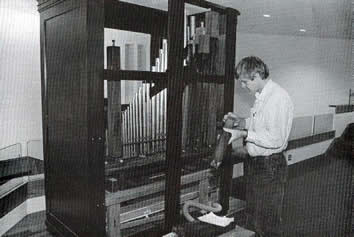
Alaska’s Oldest Organ Plays Again After a Century
By David Dahl
After about 100 years of silence and a fire which caused its near destruction, the 1844 Estonian-built organ by Ernst Kessler for Sitka Lutheran Church is restored and playing once again. Russian Alaska in the early 1800s and the arrival of that territory’s first pipe organ in 1844 in New Archangel (now Sitka) involves a fascinating history of fur traders, Finnish and German Lutheran pioneers, native Americans, and the Russian Orthodox Church. Sitka is a picturesque historic island city in the middle of Southeast Alaska, amid mountains, fjords and forests, where the American bald eagle is a common everyday sight.
The discovery of Alaska in 1741 is credited to Vitus Bering, a Dane (and incidentally a Lutheran) in the service of the Russian Navy. Claimed as Russian territory, Alaska became a rich source of fur trading, fishing, and lumber. By 1799 Russian fur trade was organized under the Russian-American Company, a monopoly enjoying full privileges of the Russian government, its sphere of operations being a part of the Czar’s empire. Early Russian Orthodox missionaries sent from Siberia to Alaska arrived in Kodiak in 1794 and started work among the Aleut and Koniag Indians and later with the northern Eskimos and the Tlingit Indians. By 1840 there were four Russian Orthodox churches in Alaska, including churches in Kodiak, Unalaska, Atka, and the Cathedral of St. Michael the Archangel in New Archangel. It was not until after 1867, when Alaska was sold by Russia to the United States that the city became known as Sitka, a community make up of Russians, Aleuts, Tlingit, Creoles, Finns, and Germans.
By 1840 there were approximately 150 Lutherans in the service of the Russian-American Company, mostly Finns (including Swedish Finns) and Baltic-area Germans. These Lutherans had neither pastor nor church, nor were their spiritual needs being tended. The Russian government came to realize that it was in their best economic interest to recognize the religious rights of these peoples and to establish a Lutheran parish in Alaska. At the same time the Russians prohibit any propagation of their beliefs beyond their own domain. The governor of Russian America at this time was Admiral Arvid Adolf Etholén, a Finn who served from 1840-1845. Etholén had first come to Alaska in 1818 as a teenage sailor in the Imperial Russian Navy. Combining naval duties with his for the Russian-American Company, Etholén soon was one of Alaska’s most important 19th-century leaders throughout an extensive and distinguished career. On a visit to Helsinki in 1838 he met his wife-to-be, Margareta, a deeply religious Lutheran.
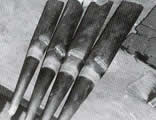
Although prior efforts to provide a pastor for the Lutheran of Sitka and surrounding area had been discouraged by the Orthodox Church and its local bishop, Innocent, official permission was ultimately granted to appoint a Lutheran pastor to Alaska, with the right to establish a congregation as a part of the Lutheran diocese of St. Petersburg (Russia). The minister was to be a Finn, and his salary was to be paid by the Russian-American Company, together with a one-percent self-imposed salary tax voted for by the congregation. Thus the appointment of Pastor Uno Cygnaeus, the first Lutheran pastor in Alaska and of all Western America, appears to have come about largely as the result of mutual concerns by Governor Etholén, his new wife Margareta, and Varon von Wrangel, director of the Russian-American Company.
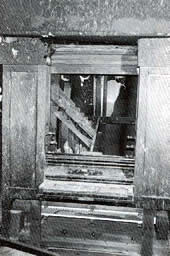 Boarding
the Nikolai 1, a 450-ton, 10 gun sailing ship in 1839, the
Etholéns together with Pastor Cygnaeus, began their nine month
voyage from Finland to Alaska around Cape Horn. During the journey
Cygnaeus began serving part of his new congregation on board ship.
He baptized the Etholéns newborn son, Edward, and presided
at the marriage of a crew member. Shortly after the arrival of the Nikolai in
New Archangel on May 12, 1840, the first Lutheran congregation in
Alaska was established. From 1840 until 1843 the congregation worshipped
in the Green Room of the Governor’s mansion known as “Baranof’s
Castle.” Cygnaeus quickly set about the building of a new church,
which was consecrated in the summer of 1843. Services were conducted
in Swedish, Finnish, and German. Orthodox Bishop Innocent had been
unhappy about the construction of the new edifice and insisted that
it should not “look like a church” since it was on the
main street near St. Michael’s Church, first built in 1826
and replaced in 1848 with a grader building known as St. Michael’s
Cathedral.
Boarding
the Nikolai 1, a 450-ton, 10 gun sailing ship in 1839, the
Etholéns together with Pastor Cygnaeus, began their nine month
voyage from Finland to Alaska around Cape Horn. During the journey
Cygnaeus began serving part of his new congregation on board ship.
He baptized the Etholéns newborn son, Edward, and presided
at the marriage of a crew member. Shortly after the arrival of the Nikolai in
New Archangel on May 12, 1840, the first Lutheran congregation in
Alaska was established. From 1840 until 1843 the congregation worshipped
in the Green Room of the Governor’s mansion known as “Baranof’s
Castle.” Cygnaeus quickly set about the building of a new church,
which was consecrated in the summer of 1843. Services were conducted
in Swedish, Finnish, and German. Orthodox Bishop Innocent had been
unhappy about the construction of the new edifice and insisted that
it should not “look like a church” since it was on the
main street near St. Michael’s Church, first built in 1826
and replaced in 1848 with a grader building known as St. Michael’s
Cathedral.
Governor Etholén was the apparent donor of the five-stop, one-manual Kessler pipe organ, which was built in Tartu (Dorpat), Estonia, in 1844 by the “master of Tartu.” The organ arrived by ship from Estonia in 1845 or 1846. Margareta Etholén had apparently purchased a reed organ or perhaps a harmonium in St. Petersburg, Russia, and brought it with her along with a barrel organ, suggesting her interest in music, and in particular, organ music. Records indicate that an organ of some sort was used for worship prior to the Kessler organ – and likely one of Margareta’s instruments.
The Kessler pipe organ, probably the first pipe organ in any church on the Pacific coast north of Mexico, was initially described incorrectly in early Sitka records as a “six toned reed [sic] organ.” Six drawknobs do exist on the organ, but one stopknob is labeled “Nihil,” meaning literally nothing. (This knob had been previously misread as Zihil: Paul Schneider in the article, “An Historic Kessler Organ in our Forth-Ninth State,” (Tracker 20:2:14), states “I have been unable to find the meaning of the drawknob marked ‘Zihil,’” presuming it to be some kind of speaking stop.)
Cygnaeus served as pastor of the Lutheran congregation from 1840-1845. Both Cygnaeus and the Etholén family left Sitka May 16, 1845, to return to Finland, where they remained. Because of shipping delays, neither the alleged donor Governor Etholén, nor Pastor Cygnaeus was unfortunately able to hear the organ prior to their departure. The long-awaited new organ was placed on a small balcony in the rear of the new church, where it was used for approximately forty years. Cygnaeus’ successor was Pastor Gabriel Plathan, whose father and grandfather had been cantors in the local parish church of Saarijärvi, Finland. One might assume from this background that a respect for fine worship and music was part of Pastor Plathan’s ministry in the Sitka congregation.
The first organist to play the Kessler instrument was a Baltic-German bookkeeper, Andreas Höppner, from Tallinn, who, apparently to Pastor Cygnaeus’ dismay, could only “compose” [sic] or perform dance music. Höppner’s successor, reportedly more successful as a liturgical organist, was Aaron Sjöstrom, the Finnish manservant of Cygnaeus and the verger of the Lutheran congregation who had come to Sitka with Höppner in 1839.
The city of Sitka had two schools run by both the Orthodox Church and the Russian-American Company. Both Etholén and Cygnaeus were strong supporters of good schools and education, both in Sitka and in other parts of Alaska as well as in the native Finland. In fact, upon his return to Finland, Cygnaeus rose to fame as a leading educationist and has been honored ever since as the rue organizer and father of the Finnish elementary schools. Music was added to the Sitka school curriculum in 1845 (approximately one year prior to the arrival of the organ), presumable to produce musicians for the orchestra established at Sitka in 1839.
The Finnish Lutheran congregation worshipped in their church with its Kessler organ from 1846 to 1867. In 1867, the year that Alaska was transferred from Russian to U.S. ownership, many Finnish Lutherans returned to Europe, greatly reducing the size of the congregation. After this time the church building was less regularly used, although some worship services are known to have taken place until the 1880s.
In 1888 Dr. Sheldon Jackson, a pioneer Presbyterian missionary and founder of the present Sheldon Jackson College, inspected the abandoned church and saw that it had greatly deteriorated. In order to preserve things of value, he removed the pulpit, organ, and altar railing to the museum he had established at the Presbyterian Mission. In this same year the church building was condemned and demolished. The organ was briefly taken out of the museum buy apparently potentially costly repairs to the instrument caused it to be returned to the museum where it remained, reportedly in unplayable condition.
Although Lutheran activity was diminished in the late 19th century, nevertheless and active, corporate Lutheran congregation remained in Sitka, as evidenced by Board of Trustees meetings and laymen-led worship services for a growing number of Scandinavian Lutherans immigrating to Sitka. After an interim period of lay leadership Sitka Lutheran organized itself as an American (Territorial) corporation in 1935 and in 1942 the second new church building was dedicated.
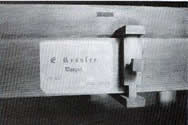 When,
in 1983, the organ, now unplayable, was moved to the third new building
(1967) for Sitka Lutheran Church, discussion took place concerning
the possible fundraising for its restoration, though no course of
action was determined. On December 9, 1993, a fire occurred, seriously
damaging the church and some of its contents. The organ was also
damaged but fortunately not beyond restoration. According to Harvey
Brandt, the church’s unofficial historian, members of Sitka
Lutheran and others in the community were “deeply saddened
at the possible loss of the organ, an important historical artifact
of the city’s history, not to mention a potentially useful
musical instrument for the church.”
When,
in 1983, the organ, now unplayable, was moved to the third new building
(1967) for Sitka Lutheran Church, discussion took place concerning
the possible fundraising for its restoration, though no course of
action was determined. On December 9, 1993, a fire occurred, seriously
damaging the church and some of its contents. The organ was also
damaged but fortunately not beyond restoration. According to Harvey
Brandt, the church’s unofficial historian, members of Sitka
Lutheran and others in the community were “deeply saddened
at the possible loss of the organ, an important historical artifact
of the city’s history, not to mention a potentially useful
musical instrument for the church.”
Fortunately an insurance settlement provided funds for Sitka Lutheran Church to restore the organ, a project fro which Austrian-born organ builder Martin Pasi of Roy, Washington, was chosen. Work commenced in the spring of 1995, with completion celebrated in September at a gala open house at the organ shop.
The organ bears the inscription: E. Kessler, Dorpat (named Tartu by the Russians), No. 45, Anno 1844. Dorpat is a city in Estonia halfway between Helsinki, Finland, and Riga, Latvia. Organs were widespread in Estonia during the 19th century, and Kessler built instruments for churches, schools, and also for residences, as a number of homes were known to have small organs similar to the Sitka organ. Apparently the Kessler organ shop was destroyed during World War II.
 The
overall height of the organ is 89 inches; width is 65 inches and
depth, 35 inches. The keyboard is constructed so that it can fold
up vertically into the case; three square stopknob shanks are positioned
at each end of the keyboard, pulling sideways toward the center of
the case. Presumably both folding keyboard and sideways stopknobs
were designed for safety in shipping, avoiding any protruding parts
in the case. An iron pump-handle is attached at the lower center
of the case front and may operate by foot a wedge feeder bellows
connected to the parallel-rise primary bellows. An electric blower
is newly installed, permitting the organist a choice of wind supply.
The
overall height of the organ is 89 inches; width is 65 inches and
depth, 35 inches. The keyboard is constructed so that it can fold
up vertically into the case; three square stopknob shanks are positioned
at each end of the keyboard, pulling sideways toward the center of
the case. Presumably both folding keyboard and sideways stopknobs
were designed for safety in shipping, avoiding any protruding parts
in the case. An iron pump-handle is attached at the lower center
of the case front and may operate by foot a wedge feeder bellows
connected to the parallel-rise primary bellows. An electric blower
is newly installed, permitting the organist a choice of wind supply.
The original case was so badly damaged by fire that a replica had to be constructed. Pasi fabricated the new case out of the same type of wood used by Kessler, i.e. Baltic birch. Michael Reiter (Eatonville, Washington, piano technician, and expert wood finisher) applied a faux “Imperial” wood-grain paint in the same manner and color of the original. Study of an unburned portion of the original case permitted a chose match to be achieved. No back existed for the original case, nor does it now. The front of the case has a frame for holding a fabric “curtain” to screen the pipes. Because further information is needed regarding what this material might have been, no screening has been used to date. The badly burned original casework was returned to the church along with the restored organ.
Wind pressure for the organ is 42 mm. This pressure could be established with certainty because of the enclosed sealed wooden box containing bricks for weight dovetailing into the top of the bellows. Martin Pasi expressed his surprise that the pipes would work so well on the low pressure given their moderate-to-high mouth cutups (with the exception of the Gedeckt 8, which has a rather low cutup). Metal pipes are of 63% tin and 37% lead, with thin tapered pipe walls. Most pipes have wide flues, with consistent light-to-moderate nicking. Pipes are racked in such a way that they cannot swivel or change position, once again very likely to prevent tuning-voicing changes in long-distance shipping.
All action parts were preserved and merely cleaned. The keyboard required resurfacing; new ebony was fitted to the naturals and recycled ivory was fitted to the sharps. Original key action appears to have been quite stiff, likely to insure against pallet problems after shipping and because no service would be available to the organ upon its arrival. In the restoration Pasi releathered the pallets and lightened the pallet strings, resulting in a graciously light and responsive action.
Fire damage affected only the top of about half of the pipes (new tops were made of the same metal alloy), but fortunately did not affect of alter the “speaking” portion of any pipes, thus making it possible to know quite precisely how the organ was originally voiced.
Pasi has expressed high admiration for the quality of organbuilding he found in the Kessler instrument and remarks that he gained some insights, particularly in voicing matters, as a result of working on the project. His goal was to bring forth the original sound of the instrument as much as possible, avoiding unnecessary alterations or changes. The reaction of the large group who heard the organ at the Pasi shop was that the Kessler instrument possesses colorful charm, interesting speech, and a gently intensity. A particularly effective and thorough demonstration was provided by organist Roger Sherman of Seattle.
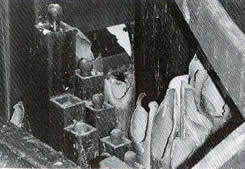 The
Ernst Kessler organ, perhaps the oldest organ built for a client
on the West Coast of the United States, was sent by barge back to
Sitka to the now-rebuilt Lutheran Church. It speaks from a prime “swallow’s
nest” location in the rear gallery, perhaps not unlike its
first location; it is once again in regular use for worship after
a century of silence.
The
Ernst Kessler organ, perhaps the oldest organ built for a client
on the West Coast of the United States, was sent by barge back to
Sitka to the now-rebuilt Lutheran Church. It speaks from a prime “swallow’s
nest” location in the rear gallery, perhaps not unlike its
first location; it is once again in regular use for worship after
a century of silence.
Resources
Brandt, Harvey. “Sitka Lutheran Church: The Finnish Legacy in Russian American,” unpublished article, undated.
Estnische Kirchenorgeln (Historical Organs in Estonia). Ed. By Andreas Uibo, Jüri Kuuskemaa. Lilientahl/Bremen: 1994.
Harjunpaa, Toivo. “The Lutherans in Russian Alaska,” from Pacific Historical Review 37:2 (May 1968).
Lönnbeck, Gustaf F. Uno Cygnaeus: The Father of the Finnish Elementary School System. Helsinki: Otava, 1890 (2nd ed. 1910). Trans. By Panu Hallamaa, Sitka, 1994.
Pasi, Martin. An interview by David Dahl concerning the technical data related to the restoration of the Kessler organ. (December 1995).
Schneider, Paul. “An Historic Kessler Organ in our Forty-ninth State,” The Tracker 20:2 (1976).
Varjola, Porjo. The Etholén Collection: The ethnographic Alaskan collection of Adolf Etholén and his Contemporaries in the National Museum of Finland. Pub. by the National Board of Antiquities.
Ackowledgements
Harvey Brandt and members of the Sitka Lutheran Church history committee as well as a long list of community and congregation members.
Martin Pasi and Co., Organ Builders.
David Dahl, AAGO, is Professor of Music and University Organist at Pacific Lutheran University, and Director of Music Ministries at Christ Episcopal Church, both in Tacoma, Washington. He has been active as a recitalist, clinician, and organ consultant for over thirty years. Mr. Dahl will play on the restored Kessler organ in Sitka later this summer.
Re-printed with the permission of "The Tracker" magazine. This article was originally published in The Tracker Magazine in 1996.